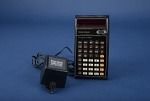Digital Equipment Corporation
Description
In the early 1980s, Digital Equipment Corporation (DEC) was the second largest computer company in the United States, following IBM, and was the leading producer of minicomputers. DEC had missed the initial development of personal computers, but decided to enter the market with a 16 bit machine. In 1982, it introduced the DEC Rainbow 100, for a price of $2,500.The Rainbow 100 had both a Z-80 and an Intel 8088 microprocessor that ran at 4 MHz. It had 64 KB or RAM and 24 KB of ROM and had two built in floppy drives that could accommodate 400 KB single-sided quad density disk. It had three operating systems: MS-DOS, CP/M-86, and CP/M. Users made a selection by a menu at boot time. The Rainbow could be used for word processing, spreadsheets, and games, although it had a monochrome screen. In addition to operating as a stand-alone computer, the Rainbow worked effectively as a VT-100 or VT-220 terminal emulator on larger machines, such as DEC's minicomputers. Although the Rainbow was a powerful and effective personal computer, it was not fully compatible with IBM systems, and eventually was overshadowed and undersold by IBM clones.Currently not on view
Plastic (Overall Material)Metal (Overall Material)
Steve Lubar





















